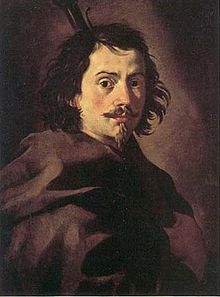Borromini
| Francesco Castelli | |
|---|---|

Borromini (anonymous youth portrait)
|
|
| Born |
25 September 1599 Bissone, Ticino, Old Swiss Confederacy |
| Died | 2 August 1667 (aged 67) Rome |
| Occupation | Architect |
| Practice | Francesco Borromini |
| Buildings | San Carlo alle Quattro Fontane, Sant'Agnese in Agone, Sant'Ivo alla Sapienza, Oratorio dei Filippini |
Francesco Borromini, byname of Francesco Castelli (25 September 1599 – 2 August 1667), was an Italian architect born in today's Ticino who, with his contemporaries Gian Lorenzo Bernini and Pietro da Cortona, was a leading figure in the emergence of Roman Baroque architecture.
A keen student of the architecture of Michelangelo and the ruins of Antiquity, Borromini developed an inventive and distinctive, if somewhat idiosyncratic, architecture employing manipulations of Classical architectural forms, geometrical rationales in his plans and symbolic meanings in his buildings. He seems to have had a sound understanding of structures, which perhaps Bernini and Cortona, who were principally trained in other areas of the visual arts, lacked. His soft lead drawings are particularly distinctive. He appears to have been a self-taught scholar, amassing a large library by the end of his life.
His career was constrained by his personality. Unlike Bernini who easily adopted the mantle of the charming courtier in his pursuit of important commissions, Borromini was both melancholic and quick in temper which resulted in him withdrawing from certain jobs, and his death was by suicide.
Probably because his work was idiosyncratic, his subsequent influence was not widespread but is apparent in the Piedmontese works of Camillo-Guarino Guarini and, as a fusion with the architectural modes of Bernini and Cortona, in the late Baroque architecture of Northern Europe. Later critics of the Baroque, such as Francesco Milizia and the English architect Sir John Soane, were particularly critical of Borromini’s work. From the late nineteenth century onwards, interest has revived in the works of Borromini and his architecture has become appreciated for its inventiveness.
Borromini was born at Bissone, near Lugano in the Ticino, which was at the time a bailiwick of the Swiss Confederacy. He was the son of a stonemason and began his career as a stonemason himself. He soon went to Milan to study and practice his craft. He moved to Rome in 1619 and started working for Carlo Maderno, his distant relative, at St. Peter's and then also at the Palazzo Barberini. When Maderno died in 1629, he and Pietro da Cortona continued to work on the palace under the direction of Bernini. Once he had become established in Rome, he changed his name from Castelli to Borromini, a name deriving from his mother's family and perhaps also out of regard for St Charles Borromeo.
...
Wikipedia
